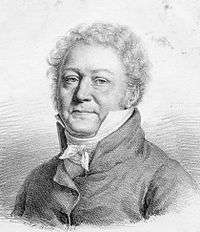Guillaume Guillon-Lethière
| Guillaume Guillon-Lethière | |
|---|---|
 | |
| Born |
10 January 1760 Sainte-Anne, Guadeloupe, France |
| Died |
22 April 1832 (aged 72) Paris, France |
| Nationality | French |
| Known for | painting |
| Movement | Neoclassicism |
| Awards | Prix de Rome, Second Grand Prize |
| Patron(s) | Jean-Baptiste Descamps, Gabriel-François Doyen |
Guillaume Guillon-Lethière (10 January 1760 – 22 April 1832) was a French neoclassical painter.
Life
Born in Guadeloupe in 1760 to a French colonial official named Pierre Guillon[1] and a disenfranchised "mulatto" mother,[2] Lethière has been often written about in the context of French colonial history and the French Revolution.
At 14 years old, he moved from Guadeloupe to Metropolitan France, and by 17 he had become the student of Gabriel François Doyen at the Académie Royale de Peinture et de Sculpture.[1] Lethière won second prize in the Prix de Rome of 1784 for his painting Woman of Canaan at the Feet of Christ. He entered again two years later, and while he did not win, he succeeding in receiving support to travel to Rome where he further developed his neoclassical style. Lethière remained in Rome for several years, and returned to Paris in 1791 to open a painting studio in direct competition with Jacques-Louis David.[3] In 1818 Lethière was finally elected and also awarded the Légion d’honneur,[4] and a year later he became a professor at the École des Beaux-Arts.[3]
Among his students were Isidore Pils and Lithuanian painter Kanuty Rusiecki. He was foster father to Mélanie d'Hervilly, later Hahnemann.
Gallery
 The Death of Cato of Utica (1795) Hermitage Museum
The Death of Cato of Utica (1795) Hermitage Museum Philoctetes on the Island of Lemnos, (1798) Louvre
Philoctetes on the Island of Lemnos, (1798) Louvre The Sleep of Venus (1802)
The Sleep of Venus (1802) The Oath of the Ancestors (1822)
The Oath of the Ancestors (1822)
References
- 1 2 "Guillaume Guillon-Lethière (1760-1832), peintre oublié". Guadeloupe-fr.com. Retrieved 2017-07-20.
- ↑ "Guillaume Guillon Lethiere - FRONTLINE - PBS". Retrieved 15 April 2016.
- 1 2 Simon Lee, "Lethière [Lethiers; Letiers], Guillaume [Guillon]" Grove Art Online. Oxford University Press, [14-02-2007], http://www.groveart.com/
- ↑ "certificate of the legion of honor". culture.gouv.fr. Retrieved 2017-07-20.
Further reading
- B. Foucart, G. Capy and G. Flrent Laballe, Guillaume Guillon Lethière (Paris and Point-à-Pitre, 1991).
- Darcy Grimaldo Grigsby, "Revolutionary Sons, White Fathers and Creole Difference: Guillaume Guillon Lethière's Oath of the Ancestors of 1822" Yale French Studies 101 (2002): pp. 201–226.
- T. Oriol, Les Hommes célèbres de La Guadeloupe (Basse-Terre, 1935), pp. 39–47.
External links
-
 Media related to Guillaume Guillon Lethière at Wikimedia Commons
Media related to Guillaume Guillon Lethière at Wikimedia Commons